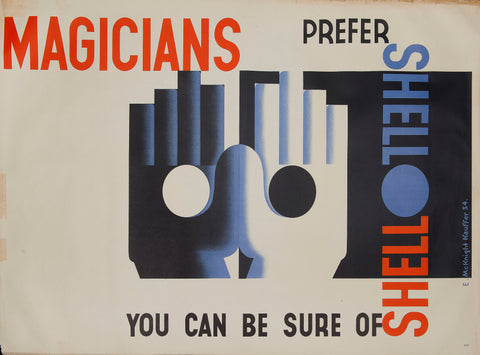SALE NOW LIVE
CLICK HERE FOR FULL DETAILS
The Sale
This month Twentieth Century Posters will be selling a highly significant collection of 27 original Shell Oil 'lorry bill' posters designed by Edward McKnight Kauffer between 1929 and 1939.
The collection will go live on our website on Saturday 26 November, with individual posters offered at fixed prices on a first come basis. Join our newsletter for early notification.
High resolution images are available in advance by email, and the individual posters can be inspected at our gallery: 40 Cross Street, Islington, London, N1 2BA.

Provenance
The posters were originally acquired by the leading British graphic designer Abram Games (1914-1996). It is unclear whether Games was given the posters directly by McKnight Kauffer (the two designers knew each other), or whether Games acquired the posters later from Shell-Mex. The posters formed part of Games’ personal reference collection and are being offered for sale via the Games Estate for the first time.

Kauffer and Shell
Under the creative direction of Jack Beddington, Shell Oil developed an international reputation for the outstanding quality of its printed publicity during the 1930s. At the forefront of the company’s innovative advertising campaigns were the “lorry bill” posters designed for display on the sides and tailboards of Shell trucks (see below).

Beddington’s genius lay in his careful selection of ‘fine’ and ‘commercial’ artists to create thought-provoking images selling the Shell brand, rather than specific products. Posters encouraged motorists to ‘See Britain First on Shell’ or suggested that virtually everyone preferred Shell, from farmers to actors, magicians and explorers. Soon the slogan ‘You can be sure of Shell’ was known throughout the world, while the posters transcended their original purpose to appear in popular magazines and art exhibitions.

As one of Britain’s most famous and influential poster artists, it was perhaps inevitable that Kauffer would be asked to contribute to the series. He had already produced several press ads for Shell in the 1920s, but his first poster commission came in 1929 to advertise Shell’s involvement with the International Aero Exhibition at Olympia. From the start, Kauffer’s understanding of the potential of modern graphic desgin to convey industrial power meant that he was supremely suited for the task at hand.

Over the next ten years Kauffer designed 36 posters for Shell and British Petroleum (BP) [which had combined their UK publicity and trading operations in 1932]. It was an extraordinarily successful collaboration, leading to some of Kauffer’s greatest poster designs.

The posters show Kauffer’s remarkable range and versatility, flipping from Art Deco to European modernism and ‘neo-romantic’ landscape painting in his search for the best solution to the advertising message. Some of the posters also feature the jointed robotic man Kauffer designed for Shell, which appeared on a wide range of Shell products, including enamel signs and oil cans.

The collaboration came to an end with the introduction of petrol rationing during the Second World War and Kauffer’s return to the USA in 1940. But it has left us with an incredible body of work that exemplifies the powerful symmetry between modernist graphic design and the machine age.

Find out more
Our bibliography includes several books and articles about Edward McKnight Kauffer and his influence on interwar graphic design. There’s also a recent book about Shell poster art which can be bought here, with more information online at the Shell Heritage Art Collection. An excellent summary of Kauffer’s wider career is available at the Cooper Hewitt Smithsonian Design Museum.




Comments on post (2)
Mireille Romand says:
Could you please send the entire list of posters with condition report and estimate prices, how do I bid?
Steve Chamberlain says:
In 1977, when I was writing my dissertation on McKnight Kauffer at Middlesex University, I arranged for Abram Games to visit the college and give a lecture on McKnight Kauffer and afterwards photographed all the posters he showed in the lecture.
He was very supportive and interested, a very nice guy
Leave a comment